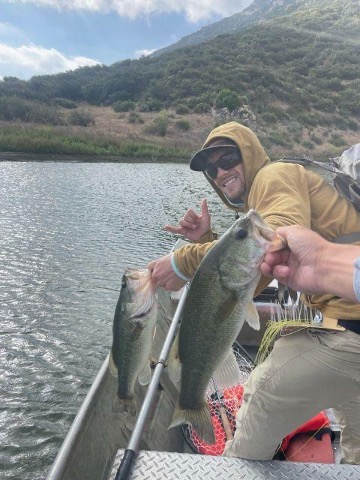Southern California has some of the best largemouth bass fishing in the nation, the subtropical climate leads to warm weather almost all year long and this is very conducive to great bass fishing. Nestled in the hills of Jamul there is a legendary bass lake that is worth any angler’s time, Barrett Reservoir. Barrett Dam was completed by the City of San Diego in 1922, creating Barrett Reservoir. Located at the confluence of Cottonwood and Pine Valley creeks, Barrett Reservoir is approximately 35 miles east of San Diego. Located behind locked gates in a remote area of San Diego County and closed for many years, access has been offered on a limited basis by reservation only since 1994. Now that its open anglers have been jumping to get their hands on tickets for every Wednesday, Saturday, and Sunday from May to September. With the season officially here, we are going to go over a few methods to some of the most consistent ways to catch fish as well as some of the funnest. A couple of the methods we will go over will be;
- Topwater
- Balanced Leech
- Swim Flies

We will start with topwater as that is what we have tied on when we hit the water. When it comes to pure excitement there isn’t much that rivals the explosion of a largemouth on topwater bait. Some of the most popular patterns thrown are frog patterns or wounded baitfish flies but larger profile items such as rats can be just as effective. Barrett is a remote lake with plenty of wildlife and there is no shortage of small terrestrial or semi aquatic creatures for the bass to feed on. You can work a frog popper along the stick lines, with some of the best blow ups happening when the dry fly has sat for a few seconds, or you can grow a baitfish fly slider with short quick strips and watch the bass come out of the weeds to smack it. Barrett Reservoir has plenty of topwater action and it’s not uncommon to see bass chasing large schools of baitfish on the surface, when you see the blow ups cast in and get ready for a fight! While not the most reliable in terms of numbers, the topwater game is a thrilling way to fish that can still produce some amazing days of fishing.
After about 9 I will usually put the topwater away, this time mark will vary depending on the fishing and if it’s ripping, I’ll go ahead and fish the topwater till they aren’t biting anymore. On the other hand, if the action is slower than I would like then I put the frog down and I fish the balanced leech. The balanced leech is your bread-and-butter dry fly setup at Barrett and in our humble opinion is the best way to consistently target numbers of fish. The reason that this technique is so effective is because when using an indicator, an angler can suspend their dry fly right next to the brush and other cover that the bass love. Because the fly fishing fly is suspended it is in the fish’s field of vision for longer and therefore often inducing a take when a normal dry fly may lose their attention. The other great thing about this technique is that you don’t get stuck very often, you can have very precise depth control as well as placement and this allows you to pinpoint your dry flies where those bass are hiding. Balanced Leeches in black are a great workhorse however a natural shad, white, and chartreuse are also good options. We have a great blog about balanced leeches if you need a brush up on tying them for your next trip! (Balanced Leech 101 | Blog TheFlyStop.com Fly Shop) (Balanced Leech Fly Pattern for Bass Fly Fishing | Blog TheFlyStop.com Fly Shop)
- Balanced leech kit
- Balanced leech
The third method is simply stripping streamer flies. More consistent than topwater and more exciting than the indicator, throwing streamer flies in varying sizes from 2 inches to 7 inches is a fun way to catch fish in which all the action comes in feeling the strike. Imagine stripping your dry fly in and suddenly you’re snagged, damn, a tree branch… But then suddenly your tree branch starts pulling back and you’ve got yourself a nice bass. I like to throw big dry flies and try to hunt for some of the bigger fish. While you will still get plenty of bites, the bigger streamer flies will tend to root out the smaller bass and the panfish in search of that hog bass. When throwing streamer flies, I have three colors: dark, a white, and natural. I like these colors because the black and white provide excellent silhouette in the water. The natural is a great color for when the water is a little clearer or the fish are being a little finicky, for Barrett it’s a shad or bluegill pattern, I’ve also had great luck with a silver color imitating the silverside minnow.

The last topic we will touch on is the amazing bluegill fishing. Whether under the indicator or stripping small streamer flies the bluegill fishery at Barrett is world class. While they might not be the primary target in the watershed, they are still super fun to fight on a light setup and eat more readily than bass. I will generally fish them with small popper flies, wooly bugger flies, or big nymph flies under an indicator, a 4wt is the rod of choice as it provides tons of play but can still handle smaller streamers. Bluegill won’t be the biggest fish you can catch in Barrett but man you will be happy you checked them out.


